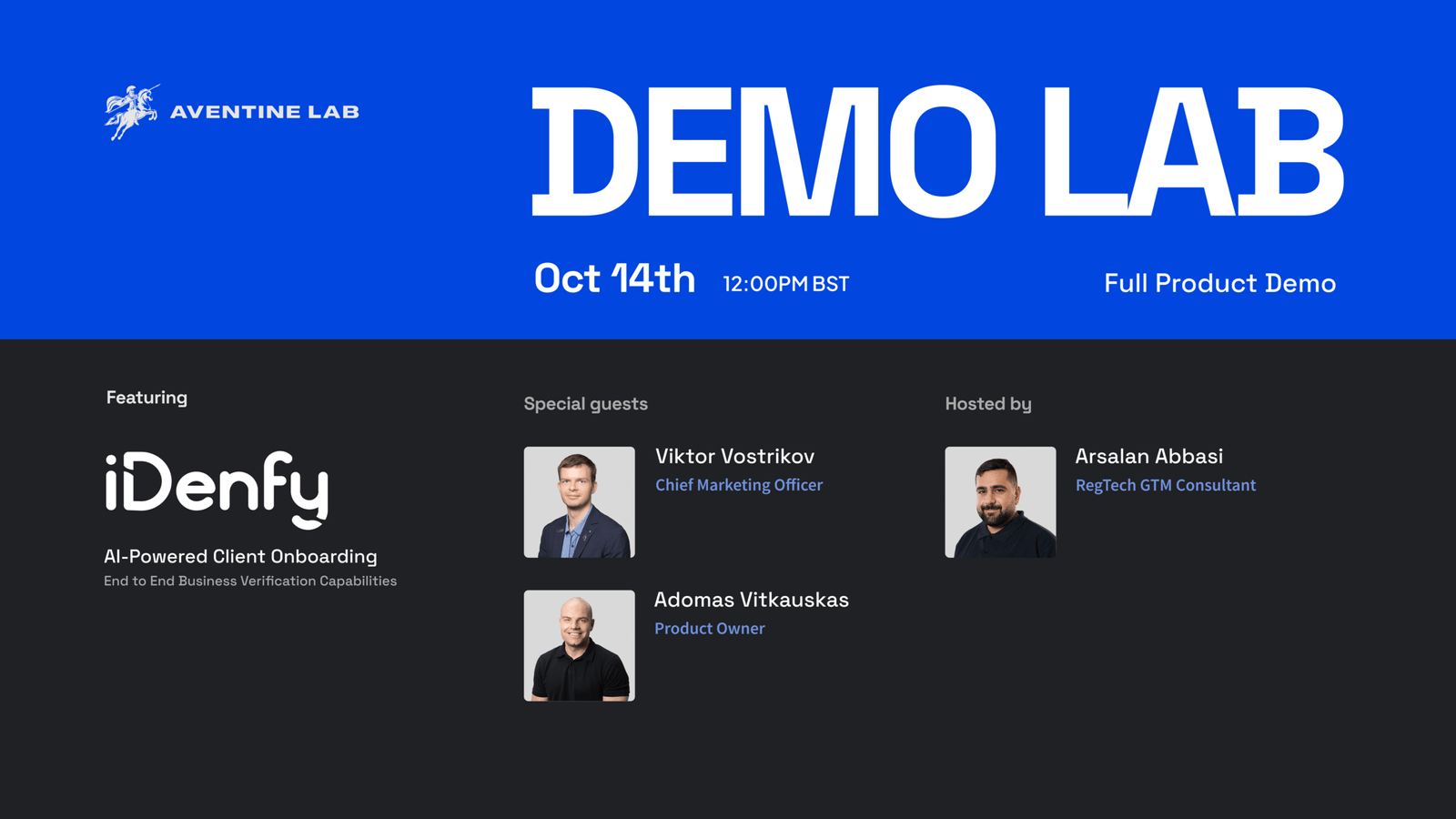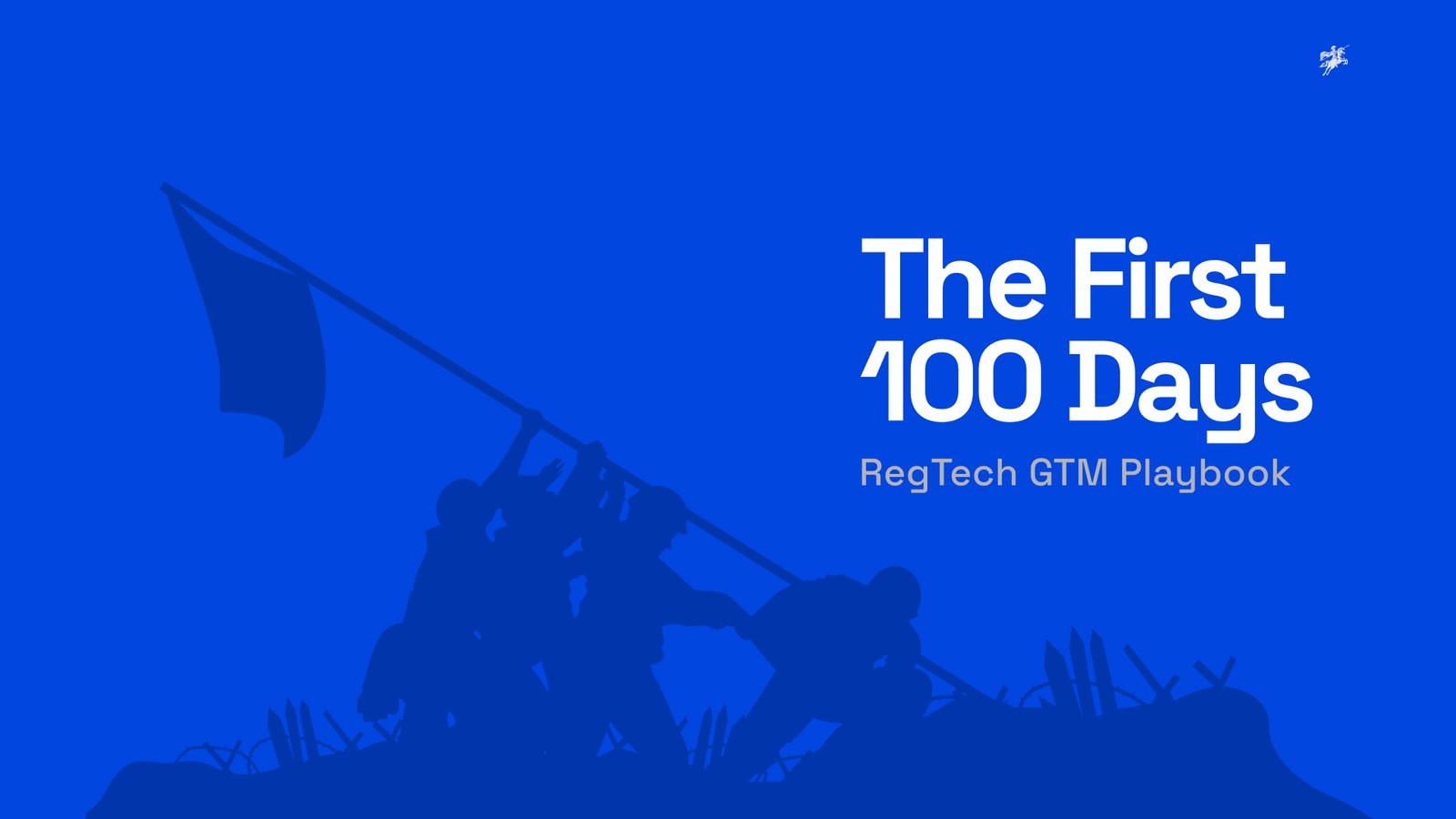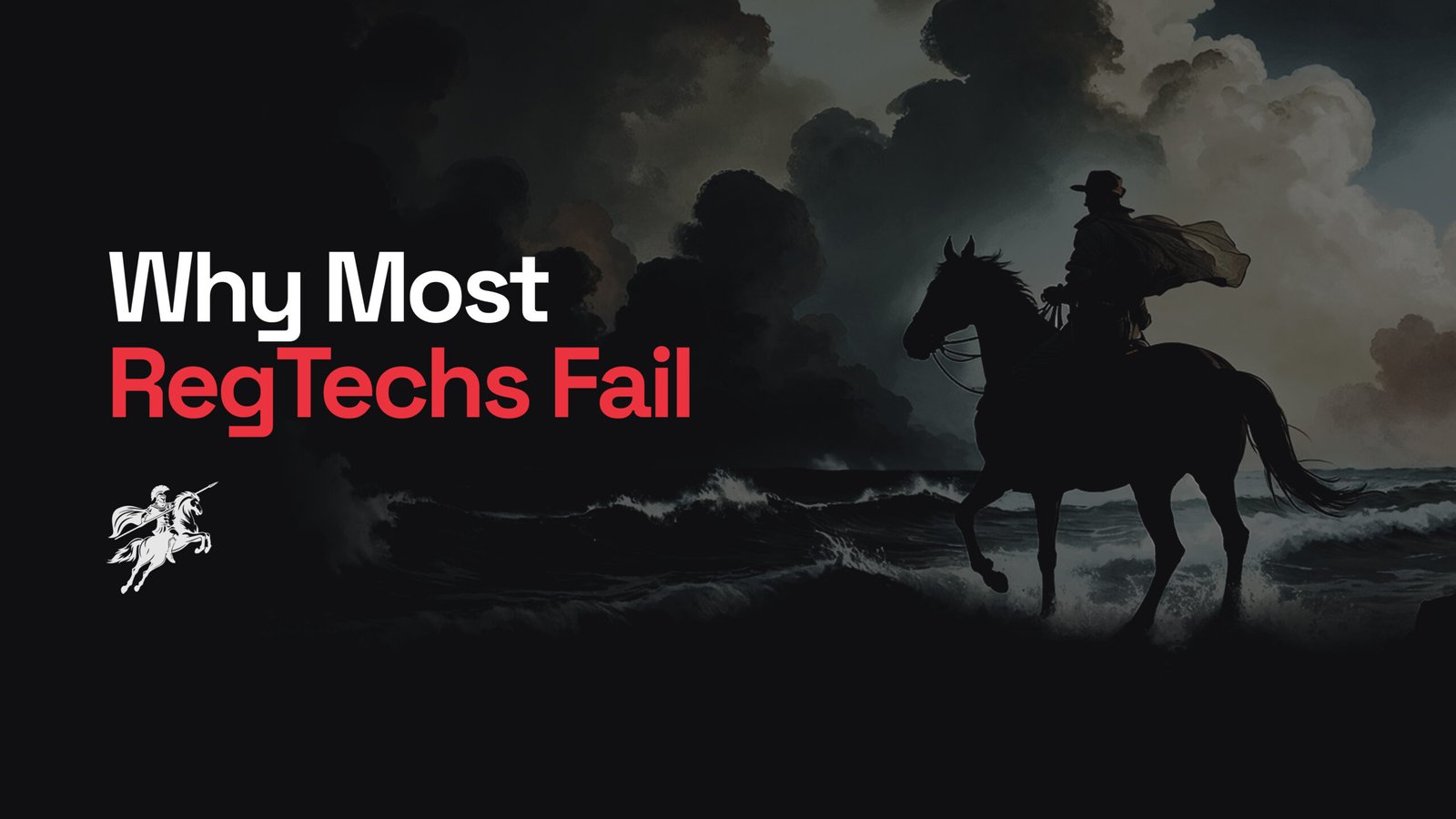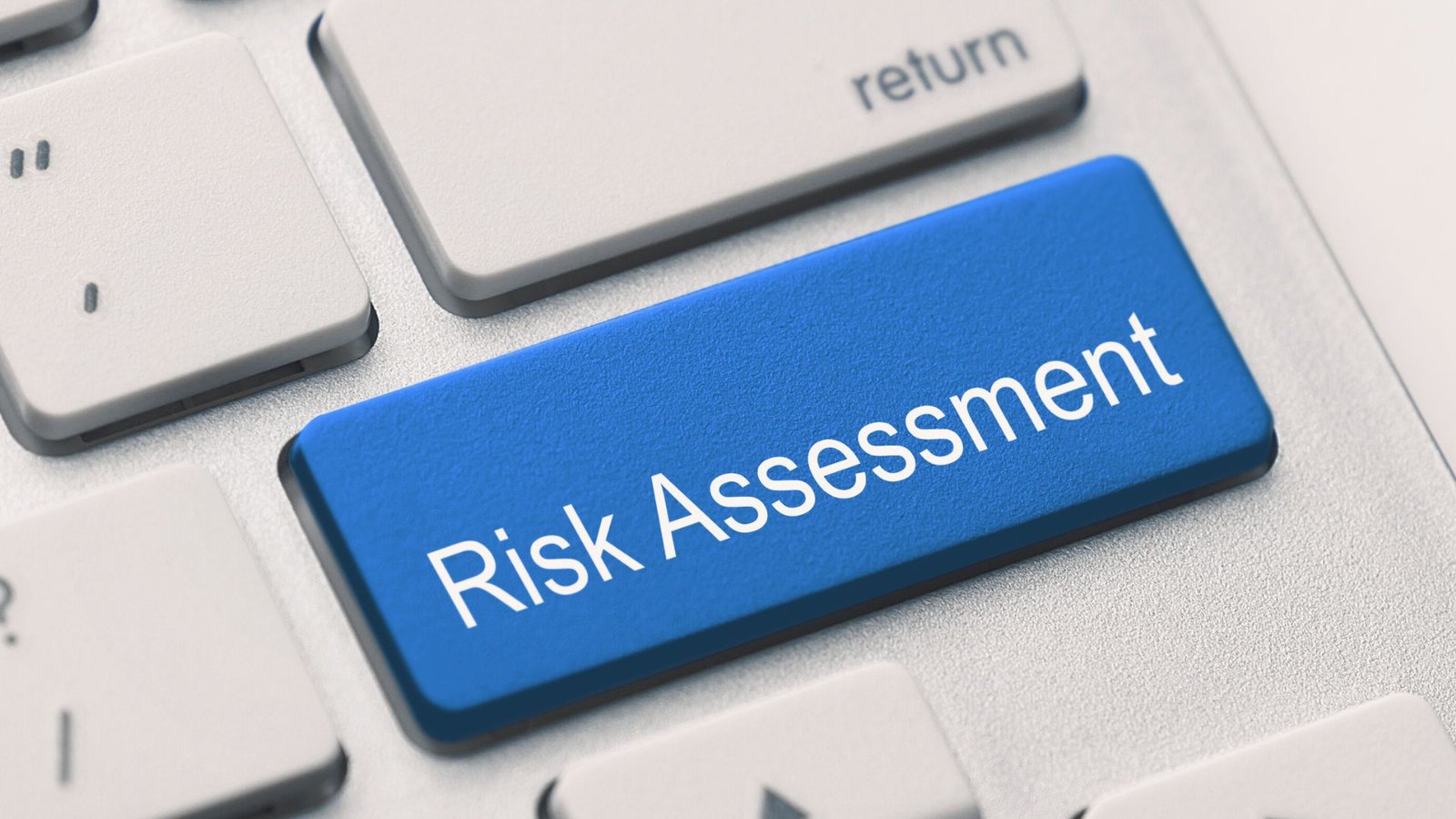Currently, there are around 2,500 LegalTech companies, and 10,000 law firms. Of these, 700 are in the mid-market and 100 are large to enterprise.
That means, there are really 800 firms of interest in UK, for thousands of Tech companies from various industries including LegalTech that want to sell to them.
Without a clear, well-researched GTM strategy, these Tech companies are doomed as lawyers are one of the toughest people to sell to.
This guide aims to be your one-stop shop, providing everything you need to understand the legal market, the LegalTech landscape, and how to create an effective market entry strategy.
Before we get started please refer to the following to enrich your understanding of the legal sector:
- 120 Legal Compliance Pain Points
- Best Risk Assessment Tools For Law Firms
- Why Risk Assessment is the biggest problem in the legal sector
The UK Legal Market
Market Overview
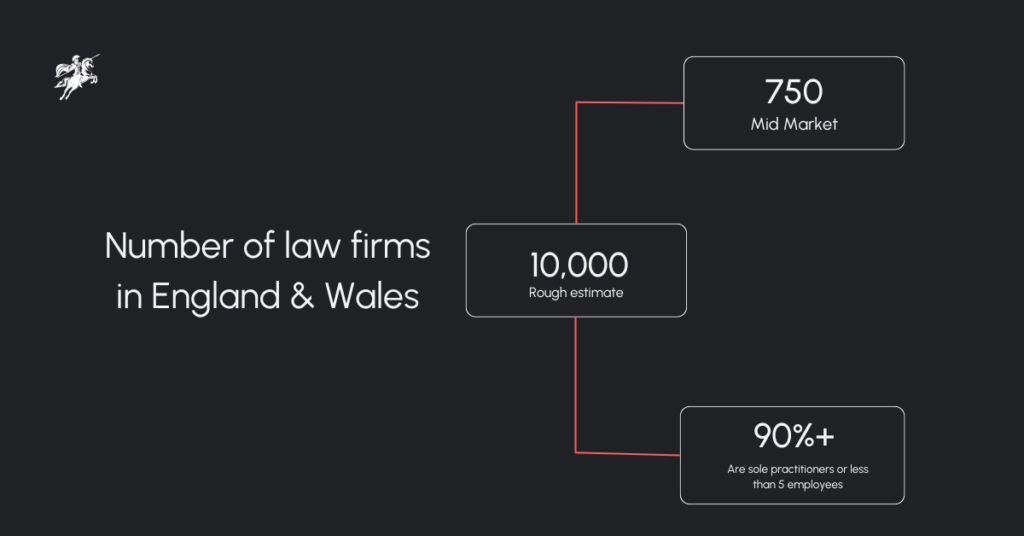
England and Wales are home to approximately 10,000 law firms. The market is dominated by top 200 firms. The top 200 firms have 50% of the total lawyers in UK working for them. Other lawyers work outside of top 200 in firms ranging from boutique to regional.
At the moment the majority of the legal firms consist of 1 to 5 lawyers, most being sole practitioners. This means that 90% of all firms are sole practitioners or 2 partners. The mid market in the UK consists of 500 firms.
The Solicitors Regulation Authority (SRA) is the primary regulatory body for all law firms in England & Wales. Upholding professional standards and ensuring ethical conduct within the legal profession. The Law Society plays a role in representing and supporting solicitors. Offering resources and advocacy for their interests.
Law Firm Structures
- Traditional Partnership: In this structure, partners share ownership and profits. However, they face unlimited liability. Meaning their personal assets could be at risk if financial troubles arise.
- Limited Liability Partnership (LLP) is a modern structure where partners enjoy limited liability. Protecting their personal assets from business debts. It’s the most common structure for law firms.
- Alternative Business Structure (ABS): This structure allows non-lawyers to own and invest in law firms. Encouraging competition and introducing novel approaches to legal services.
What services do law firms offer?
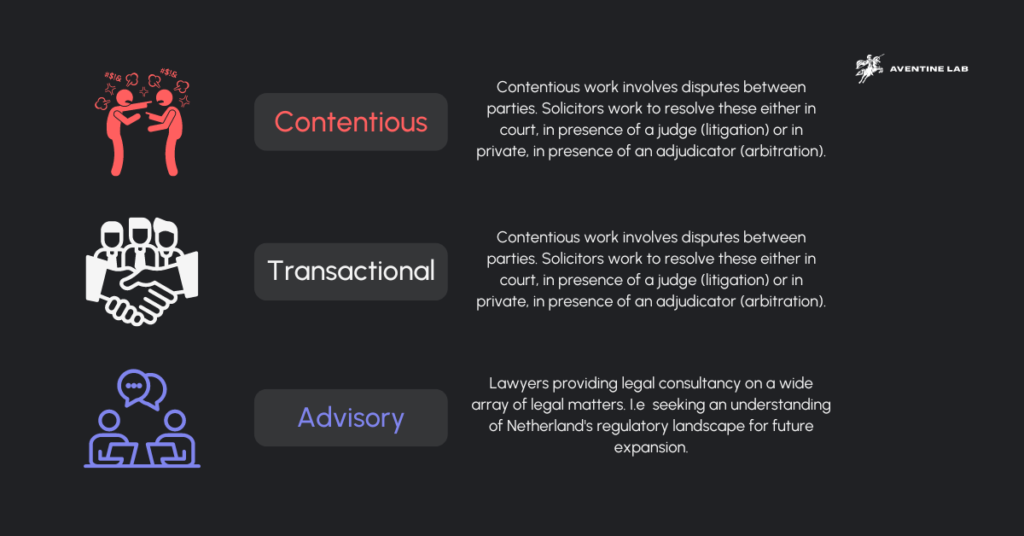
- Contentious Work (Dispute Resolution):
- Litigation firms represent clients in court. Advocating for their interests and seeking resolutions through legal proceedings.
- Arbitration is an alternative dispute resolution method. Involves a neutral third party (the arbitrator) making a binding decision outside of the court system.
- Mediation is a process where parties in conflict communicate and negotiate to reach a compromise.
- Advisory Work:
- Lawyers providing legal consultancy on a wide array of legal matters. Example can include consulting a client around Netherland’s regulatory landscape.
- Transactional Work (Non-Contentious):
- These practices consist of overseeing and facilitating the legal aspects of transactions. These can range from real estate conveyancing, mergers and acquisitions (M&A), financing deals, and IP licensing.
- Transactional lawyers oversee contract signings and out-of-court proceedings. They draft and review agreements, help structure deals and advise their clients.
- Pro Bono and Legal Aid:
- Many lawyers dedicate time and resources to pro bono work. Offering free or reduced-fee legal services to those who cannot afford them. Legal aid provides government-funded assistance to eligible individuals.
Categorising law firms by specialism
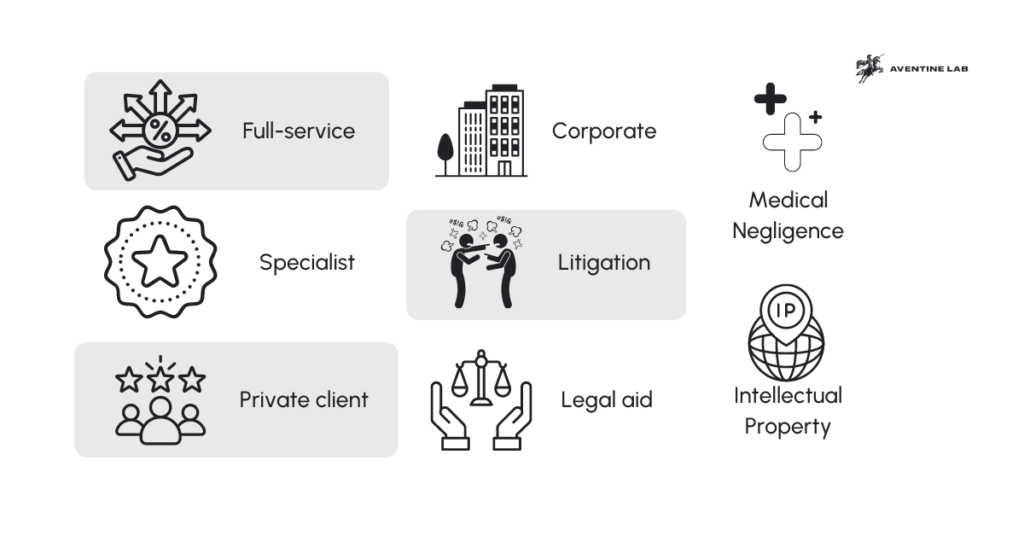
Full-service firms: These are your one-stop shops for legal advice. They do everything from drafting contracts and buying properties. To resolving family disputes and defending clients in court. These firms provide transactional and contentious services to private clients and businesses.
Specialist firms solely focus on one or two types of practice and industry. Their niche expertise is often utilised by other firms in complex legal proceedings.
Private client firms cater to individuals and people law. They help with matters like writing wills, managing estates, navigating divorce or child custody issues.
Corporate firms on the flip side work primarily with businesses. They advise on company formation, mergers and acquisitions, commercial contracts and lot more. These firms can be a mix of contentious and non-contentious.
Litigation firms: These firms specialise in taking cases to trials. Litigators spend most of their time writing briefs, memos and motions. Researching laws; reviewing documents; taking depositions and attending mandatory court appearances.
Negligence firms focus solely on cases where someone has been injured due to another’s negligence. This could be anything from a car accident to medical malpractice.
Legal aid firms: Not everyone can afford a lawyer. Legal aid firms provide free or subsidised legal services to those who cannot afford legal justice. Helping with issues like crime, housing, family law, and welfare benefits.
Understanding law firms based on size & reputation
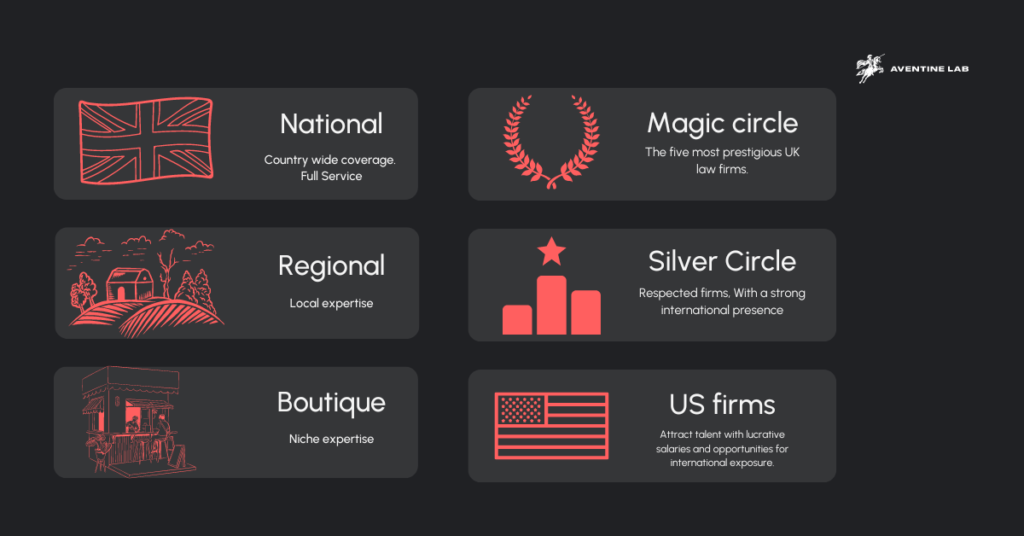
Magic Circle: The five most prestigious UK law firms. Known for their elite clientele and dominance in corporate and finance law.
- The Elite Five consisting of: Allen & Overy, Clifford Chance, Freshfields Bruckhaus Deringer, Linklaters, and Slaughter & May.
Silver Circle: Respected firms, often with a strong international presence. These firms are super competitive and can often outpace their Magic Circle rivals.
- Ashurst, Herbert Smith Freehills, BCLP Macfarlanes, and Travers Smith.
US Law Firms are expanding their reach into the UK market. These firms attract top talent with lucrative salaries and opportunities for international exposure.
- Kirkland & Ellis, Latham & Watkins, White & Case, Skadden, and others.
- Lucrative salaries, aggressive expansion strategies, emphasis on US-style legal practice, strong transactional focus.
National firms have multiple offices across the country. They have extensive resources, a broad range of practice areas, and a healthy split between private client and commercial work.
- Examples: Eversheds Sutherland, Irwin Mitchell, Pinsent Masons, Addleshaw Goddard and others.
Regional mid-sized firms offer a balance of localised service and specialised expertise in a most areas of law.
- These firms typically have multiple offices across the midlands. Handling a variety of legal matters for local businesses and individuals, often providing a more personal touch.
- These firms range from Mills & Reeve to BP Collins, Poole Alcock, DMH Stallard and so on.
Small/Boutique firms often specialise in niche practice areas. These firms can be super niche and are able to provide tailored services and expertise
- Can include firms like Rosling King, Bowling & Co, Marriot Harrison, Founders Law, Level Law, 3CS, etc
Who works in a law firm?
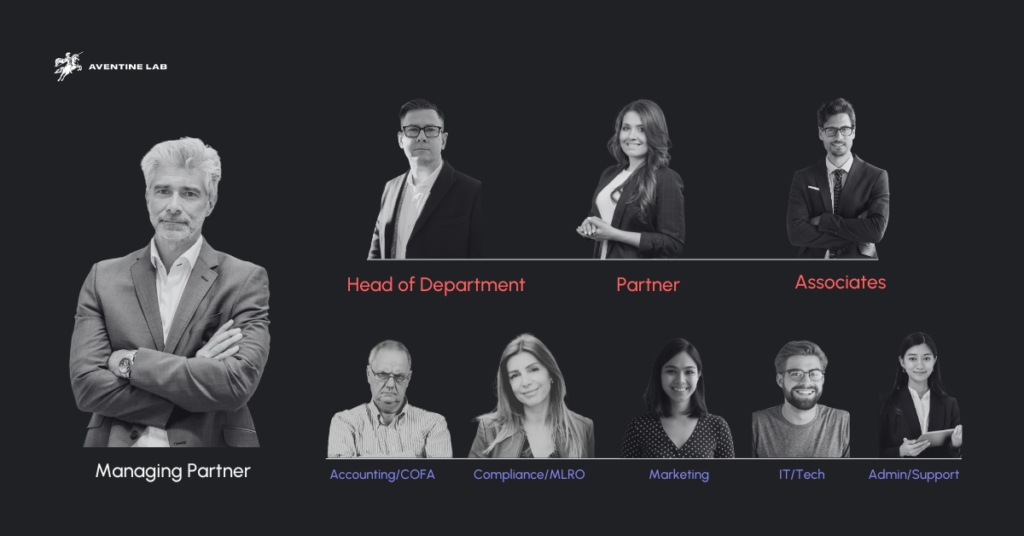
- Lawyers: Fee-earners consisting of paralegals, associates and partners. Providing legal services and advice. The main currency of a law firm is time. Lawyer record how they spend every minute of their working day to calculate how they bill the client.
- Business Support consists of Finance, Compliance, HR, and Marketing teams (typically in medium to large firms).
The LegalTech Landscape
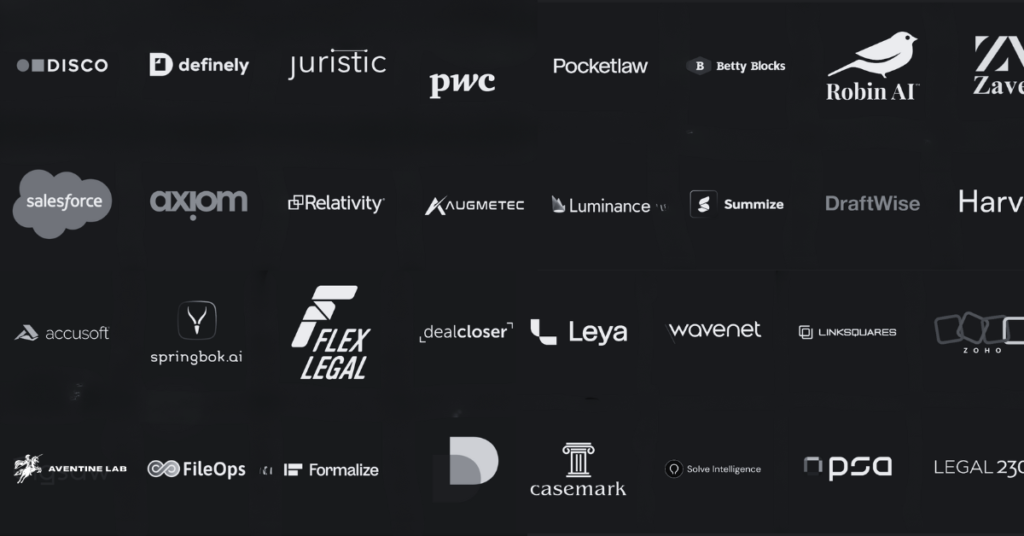
What is LegalTech?
LegalTech encompasses any technology designed to enhance a lawyer’s workflow. Think of it as the lawyer’s digital toolkit. Containing tools that streamline processes, provide data, boost accuracy, and cut costs.
LegalTech can be broadly categorised into:
- Tools for Legal Professionals: include software that aid lawyers in managing their practice. Ranging from case management systems to document automation, legal research tools, and e-billing systems.
- Tools for Consumers: include platforms that allow individuals to access legal service. Ranging from legal advice to contract automation or automated document services.
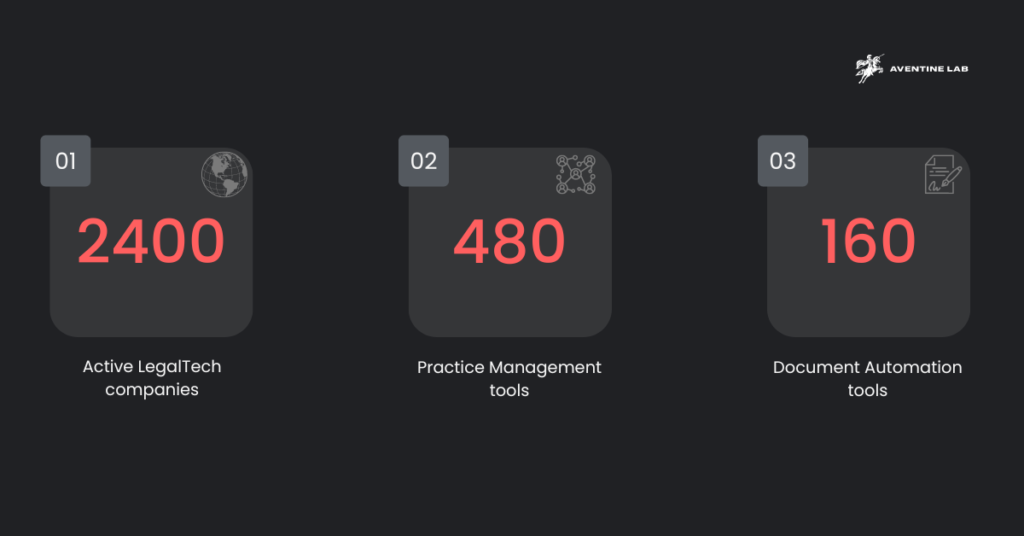
The History of LegalTech
Early Developments
LegalTech is not a new phenomenon. It has rapidly evolved over the past decade. Here’s a look at its evolution:
- 1970s: The legal industry started adopting basic electronic tools for research and case management. Lexis Nexis was a pioneer in this field, offering electronic access to legal research databases.
- 1980s: The introduction of personal computers and software applications such as word processors began to change the way lawyers worked. Lexis Nexis introduced the UBIQ terminal in 1979, which provided desktop access to their legal research database.
- 1990s: The rise of the internet brought significant changes. Email became a primary mode of communication, and online legal research tools became more prevalent. The Federal Judicial Center in the US launched the COURTRAN project, an early attempt to manage court records electronically.
The Digital Age
- 2000s: The introduction of the BlackBerry smartphone in 1999 catalyzed a shift towards mobile working, allowing lawyers to stay connected and productive while on the go. The 2000s also saw the growth of cloud computing, enabling more flexible and scalable legal practice management solutions.
- 2010s: LegalTech saw an explosion of new startups and innovations. The focus shifted towards disrupting traditional legal services with online platforms that offered automated solutions for legal tasks. Companies like LegalZoom and Rocket Lawyer emerged, providing consumers with affordable legal document automation and advice.
- 2020s: The COVID-19 pandemic accelerated the adoption of digital tools, including high-fidelity video conferencing and remote work solutions. The legal industry increasingly embraced AI and machine learning for tasks such as document review, contract analysis, and predictive analytics.
How does LegalTech work?
LegalTech solutions range from reviewing contracts and tracking billable hours to automating legal research and implementing smart contracts. These tools use automation and sometimes AI to enhance efficiency and accuracy of legal work.
Key Statistics
- Adoption Rates:
- Only 37% of UK law firms currently use legal technology. 60.9% of solicitors plan to use it more frequently in the next five years.
- A survey of 900 law firms in the UK found that only 37% are currently using legal technology.
- Investment Growth:
- LegalTech investment soared from $224 million in 2016 to $1.66 billion in 2018, showing a significant increase in interest and funding.
- By September 2019, investment in LegalTech reached $1.2 billion.
- Economic Impact:
- In 2021, LegalTech’s impact on the global economy was estimated at $127.7 billion, with forecasts suggesting a rise to over $225 billion by 2027.
- Benefits of LegalTech:
- LegalTech makes teams more productive (74%).
- Automates repetitive tasks (54%).
- Simplifies workflows (49%).
Different type of LegalTechs and what they do
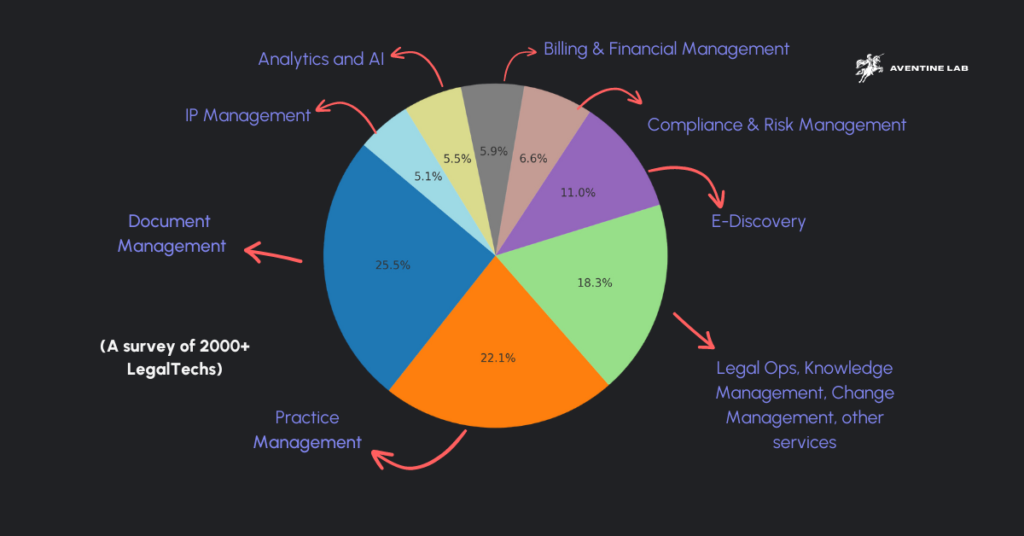
LegalTech Applications: Detailed Breakdown
LegalTech encompasses a wide range of applications, each designed to address specific needs within the legal industry. Here are some of the most common and detailed applications:
Case Management Systems:
- Used by 71% of small firm lawyers to manage cases and client information.
- These systems help lawyers organize and track their cases, manage deadlines, and communicate with clients.
- Examples include Actionstep, Leap, Clio, MyCase, and PracticePanther.
- Key Features: Calendar management, e-sig, task management, billing, document management, and client communication platforms.
Practice Management Systems:
- Provide workflow automation for particular departments within a law firm. For instance, some PMS only focus on property, others only on family or litigation.
- Examples include Rocket Matter, Legl, and Litigate.
Finance & E-billing:
- The most popular legal tech, used by 48% of law firms.
- These tools automate financial operations. They manage invoicing, expense tracking, and trust accounting.
- Commonly used tools include QuickBooks, TimeSolv, and CARET Legal.
- E-billing systems automate the invoicing process, making it easier for law firms to track billable hours and ensure timely payments.
- Benefits: Increases billing accuracy, speeds up the invoicing process, and provides transparency to clients.
Contract Lifecycle Management (CLM):
- Implemented in 44% of law firms.
- CLM technology streamlines the process of drafting, reviewing, and managing contracts, ensuring compliance and reducing risk.
- Key Features: Automated drafting, version control, and compliance monitoring.
Document [Contract] Management :
- Services like Definely, Avvoka, Concord, DocuSign, and Legal Files provided automated legal document creation and automation..
- Document automation tools use templates to generate legal documents quickly and accurately, reducing the need for manual drafting.
Legal Research Tools:
- Used by 67% of lawyers, these tools help legal professionals conduct thorough legal research, find precedents, and stay updated on legal developments.
- Popular Tools: Westlaw, LexisNexis, and Practical Law.
Cybersecurity Tools:
- With increasing cyber threats, law firms are investing more in cybersecurity technology to protect sensitive client information.
- Key Features: Data encryption, intrusion detection, and secure communication platforms.
Predictive Analytics and AI:
- AI tools are used for tasks like document review, contract analysis, and predicting litigation outcomes.
- Predictive analytics helps lawyers anticipate the likely outcomes of cases, improving their strategic decision-making.
- Applications: AI in document review and analysis, litigation prediction, and contract analytics.
Online Dispute Resolution (ODR):
- Technology platforms that facilitate the resolution of disputes online without the need for physical court appearances.
- Benefits: Reduces costs, increases accessibility, and speeds up the resolution process.
E-discovery:
- Tools that help in the discovery process of litigation by automating the identification, collection, and analysis of electronic data.
- Benefits: Increases efficiency, reduces costs, and improves accuracy in handling large volumes of data.
Client Relationship Management (CRM):
- CRM tools help law firms manage their interactions with current and potential clients.
- Key Features: Client communication tracking, relationship management, and marketing automation.
Compliance & Onboarding Systems:
- Streamline how firms conduct compliance and onboard. They range from client portals, automated intake forms, AML tools, Client Risk Assessment and reporting systems.
GTM Strategy & RevOps Are The Key To Success in LegalTech
Without GTM & RevOps Strategy you might as well give up. There is no way you will have any chance of success, selling complex solutions to the most difficult market and people in the world without it.
GTM Strategy is your roadmap to success, whilst RevOps is your step by step means of achieving it.
Let’s start with the GTM Strategy and then we’ll cover RevOps.
8 Step LegalTech GTM Strategy
As I said, Go-To-Market strategy is essential for successfully launching and promoting your LegalTech solution. This strategy should encompass in-depth amount of market research, defining pain points and your key value propositions, clear financial objectives, a multi-dimensional market entry plan, a lead generation strategy, RevOps and continuous monitoring.
Sounds like a lot, but this is what it takes to succeed. You can’t build a boat and conquer the new world without proper planning, strategy and execution.
1) Identify the problem
Start by defining the problem your product addresses, focusing specifically on the unique challenges faced by your target customers; legal firms, accountants, banks, or whomever they may be. Be very exact about the workflow, department and usecase of your product.
In identifying your problem, you should also demonstrate knowledge and understanding of your target market. You need to know the intricacies of how your customers work, why this problem exists and persists. Why nobody has done anything about it and the operational inefficiencies that your product aims to solve and be part of.
- What is the problem
- Clearly define the problem, emphasising its origins, relevance and impact on your target market.
- Demonstrate clear understanding of why the problem exists.
- Why does this problem persist in the market and why are existing solutions are inadequate?
- Measuring the size of the problem
- Provide statistics or metrics to quantify the problem’s size and the impact on potential clients.
- How important and urgent is this problem for your customers?
- Highlight the urgency and importance of solving this problem for your custome
2) Define The Solution
Articulate how your product or service uniquely solves the identified problems. Highlight the technological innovations, superior service offerings, or cost efficiencies that set your solution apart from existing alternatives.
- How are you solving this problem?
- Describe how your LegalTech directly solves the problem you showcased
- What are your key offerings that solves this problem?
- Competitive Positioning
- What makes what your product does unique? Aka, why you.
- Highlight your unique capabilities and industry expertise, demonstrating competitive superiority.
- What makes your solution unique and superior to competitors
- What makes what your product does unique? Aka, why you.
- Key Offering
- List the primary features or services of your solution that directly address the client’s needs.
- Which of the above is unique to your offering?
- Unique Selling Proposition (USP)
- Provide 3 main USPs (e.g., product influence, feature, benefits, faster implementation, better ROI, superior technology).
Here is a basic template for answering the above:
- The customer we serve is …. (who)
- The situation is … (why)
- The problem we solve is… (what)
- We solve this problem by…. (how)
3. Target Market and Buyer Personas
Define your target market with precision, focusing on specifics and detail.
Good practice:
- What market(s) are you going after? and why? Be very specific here
- “Professional services” – is not good enough
- “law firms from 20 to 100 employees”- is better
- “Law firms specialising in b2b work (tax and M&A), ranging from 20 to 100 employees, in London with high buying intent” – is perfect and achievable
- Market Size and Potential
- Analyse and define the total addressable market and the ICPs within that.
- How many law firms in the exact size, specialism and category exist in your target geography?
- Can your product go after more types of firms?
- Market Segmentation
- Identify and describe the specific market segments you are targeting, using detailed criteria (e.g., industry, size, region).
- Do you have enough firms to go after to make this viable?
- Identifying ICPs
- Create detailed ICP profiles. Define and understand their workflows, techs they use, purpose of their work, KPIs and pain points!
- Buyer Behavior
- Outline the typical purchasing processes within these segments, including key decision-makers, technical buyers and budget cycles.
- Segment Attractiveness
- What about this segment makes it attractive to target?
- How much do you think they’ll pay for a solution like yours? What is this based on?
- Consider the potential profitability and longevity of these segments, including customer acquisition costs, average contract values, sales cycles and expected lifetime value
Define your buyer to max degree:
- Your ICPs within those segments/markets:
- Who exactly are you targeting in these firms?
- What messaging resonates most for them?
- What role do they play in your deals? Economic Buyer? Technical Buyer?
- Do you understand their jobs? pain points? procurement strategies? KPIs?
- How many of these profiles have you spoke to? What traction are you getting when you speak with them?
- Does your ICP want a solution like yours?
- Who exactly are you targeting in these firms?
- How deep and extensive is your ICP profiles?
- Do you understand age ranges, communication styles, cultural differences, type of content they consume, the sort of things they follow on socials?
- Are all teams aligned on who your ICPs are and why?
- How are your ICPs using the product? Is it the same as what you intended?
Think about the following:
- Which segment produces the best ROI with the lowest CAC?
- Is the segment large enough to produce yields that align with rev goals?
- You don’t want to run out of new law firms to contact after the first year. There’s only 500 in the mid market and enterprise.
- Is the segment large enough to produce yields that align with rev goals?
- If going for the mid market, why? Is this an abandoned market? Other segments saturated?
- Do these segments have an urgent and important problem that your product solves?
- Does the mid market have a bigger, more urgent problem with the thing you are solving?
- Does this help you with your close rates? Lead gen? etc?
- Does your pricing and sales process reflect your target market?
- For example, it wouldn’t make sense to have an outbound approach to target start-ups aiming for $4k contracts.
- It also wouldn’t make sense to use marketing to snatch up enterprise accounts.
Mapping out law firms
If you truly want to understand legal and lawyer profiles you need to refer to solicitor mapping data providers such as Legal Target or Atlas. You can also use tools like Apollo AI or ZoomInfo to gather email addresses/direct dials – but these are often advertised on law firm websites, so what you want is additional data to truly understand how to sell to them.
4. Competitor Landscape (key differentiator)
Perform a detailed SWOT analysis of your competitors to understand your market position. Identify any underserved niches, such as specific compliance issues in cross-border transactions that your product addresses more effectively.
- Regularly speak to partners and interview candidates to find out what’s happening inside of your competitor’s business.
- Build a knowledge base of their pricing thro asking customers and partners.
- Find the white space that you compete on. What sets you apart from rest?
- Where and how do you win? Strategy? Product? Marketing? Pricing? Geographies? Partnerships?
- When facing competition in deals, product aside, why would the customer choose you?
- Identify opportunities where your solution can excel and threats that you need to mitigate.
- In what ways does your product, pricing or commercial strategy offer you a competitive advantage?
5. Pricing Strategy
Develop a pricing strategy that reflects the value your solution provides and the expectations of your target market. It should be easy to understand, competitive, and flexible enough to accommodate different sizes and types of clients.
- Pricing Model:
- Detail your pricing structure and the rationale behind it, considering the value provided and market standards.
- Customer Feedback:
- What have you heard from customers on ideal pricing structures?
- Have you had feedback on your pricing yet? If so, what is the consensus?
- Competitive Pricing Analysis:
- What is the pricing structure of your top competitor and in what are you competing against this?
- Segment-Specific Pricing:
- Have you created pricing strategies to different customer segments to maximize penetration and profitability?
- If so, map out at least 5 different customer profiles and apply pricing to assess suitability
- Have you created pricing strategies to different customer segments to maximize penetration and profitability?
6. Commercial (GTM) Strategy
Detail your approach to reach and convert your target audience. This includes how many opportunities you need to generate to meet revenue targets and what unique strategies you will use compared to competitors. Integrate marketing, sales, and partnerships to generate leads, focusing on creating a unified approach to customer acquisition.
- Goals and objectives
- Define your financial objectives, including revenue targets and key success metrics. These have to be based on realistic numbers tied into your market research
- Having a clear vision or outcome in mind, and then work backwards on the strategy it takes to get you there
- Market Entry Plan:
- How are you planning on launching your product?
- What is your commercial team set up?
- What is your route to market?
- In what way, does your strategy offer you a unique and competitive advantage?
- Lead Generation:
- What is your strategy for lead generation?
- How many leads do you need to reach your goals?
- Commercial Team Alignment (CTA):
- Ensure that sales and marketing strategies are fully defined, integrated and aligned with the overall GTM Strategy
- What measures will be in place to ensure alignment and effective internal communication?
7. Execution
Implement your strategy by setting clear objectives. Also, set key performance indicators (KPIs) for all departments. Ensure all teams are aligned with the GTM strategy, from marketing and sales to customer support. Employ digital assets, workflows, and advanced technologies to streamline processes and improve efficiency.
- Strategic Goals:
- Set clear, actionable goals for each department involved in the GTM strategy.
- Set up a cross departmental project management tool for teams to collaborate on projects
- Resource Allocation:
- Detail the resources (hires, techs, outsourcers) required to execute the strategy effectively.
- Collaborative Efforts:
- Highlight the importance of interdepartmental collaboration to enhance execution efficiency.
- Provide cross departmental training to all staff; I.e, sales people learning about marketing and vice versa.
- Timeline Management
- Ensure everyone is aware of the GTM Strategy and their part in this journey.
8. Monitoring and Iteration
Establish a system for consistent reporting and communication within and across teams. Use data collected from sales, marketing, and customer feedback to refine your strategies. Ensure that your business remains agile, adapting to changes in market conditions and customer needs.
- Performance Monitoring
- Establish metrics and benchmarks for ongoing assessment of the GTM strategy’s performance.
- Fostering a culture of honesty and accountability for this to work effectively.
- Feedback Mechanisms
- Implement systems to gather continuous feedback from customers and internal teams.
- Adaptation Strategies
- Conduct quarterly assessment of the GTM Strategy to find opportunity gaps or room for improvement
- Reporting and Communication
- Ensure regular reporting and communication within the team to keep everyone aligned and informed.
LegalTech RevOps Strategy
What is RevOps
RevOps is the process of integrating and optimising your resources (people, data and processes) in order to create sustainable growth, and diversify your sources of revenue. It is a framework that puts customer experience at the heart of your decision making.
RevOps brings together the efforts of sales, partnership, marketing, and customer success teams, arming them with data and automation to drive sustainable growth.
This strategic alignment is vital in sectors in LegalTech, where you are competing against thousands of others who are trying to do the exact same thing as you.
Also the prospects you are going after, if you don’t have your stuff together, they will instantly block you out. You only get one chance to make an impression and if your organisation looks disjointed with weak branding and inconsistent messaging, then you can be assured nobody is going to buy what your selling.
There are three key pillars of RevOps; Integration of teams, unified & robust Techstack as well as
RevOps in LegalTech: 9 Simple Steps for Success
1) Integration of Teams: Breaking Down Silo
Traditional structures often create silos that hinder collaboration between sales, marketing, partnership and CS teams. RevOps dismantles these barriers by fostering cross-functional integration and implementing commercial plays to replace transactional disjointed activities.
Key strategies include:
- Regular Cross-Functional Meetings: Invite marketing to sales meetings and vice versa, each to know be aware of what other is doing and be on similar wave length, contributing to the same overall projects and goals.
- Shared KPIs: Define KPIs that align with overall revenue objectives, holding teams accountable for their contributions.
- Collaborative Tools: Make sure all of the commercial team are using the same tools; Slack, Notion, HubSpot/Salesforce or intercom, they all need access and to be aware of key data and metrics.
2) Tech Stack & Process Automation
A robust tech stack, backed with intelligent and slick processes, will make you unstoppable. It enables seamless data flow, process automation, and data-driven decision-making.
Streamlining processes to improve efficiency, reduce admin time, and enhances the speed of operations across the commercial team.
This involves regular reviews and adjustments based on performance analytics.
Key components include:
- Centralise your CRM: Centralise customer data and interactions, providing a 360-degree view of the lead gen process, pipeline, customer success, partnerships and marketing. Examples include Salesforce and HubSpot. Your entire commercial team can use these two tools.
- Data Intelligence : Gather and analyse data to provide insights for decision-making. Tools like ZoomInfo and Apollo, Google Analytics, SemRush or AhRefs are valuable in this space.
- Automation Platforms: Automate sales or marketing tasks such as email campaigns and lead nurturing. For example, inbound enquiries could easily come into Hubspot and you simply tag one of your team members to follow up. Similar with Custom Intent.
A good tech-stack will arm your team with the means of cross collaborating and succeeding where others fail. This unification of your team and Tech-stack will improve your branding and you will look robust to competitors and prospects.
3) Choosing the Right Tools: Key Considerations
When selecting tools, consider:
- Scalability: Choose tools that can grow with your business, Apollo might be more appropriate than Gong or ZoomInfo at first
- But if you are going for one of these top tier tools, then make sure you negotiate a great deal.
- For instance, whilst someone might pay $50,000 for 5 ZoomInfo licenses, a savvy negotiator can get 20, for 25k. These big companies don’t care about $ quantity as much as they care about closing a deal.
- Integration: Ensure seamless integration with existing systems before purchasing any technology, you want everything to integrate into Slack, Notion and your central CRM. This is non-negotiable.
- User-Friendliness: Opt for intuitive tools that your team will love and use – don’t go for Salesforce because it has infinite add-ons and you think its industry leading. Choose something that resonates with your team and they will love to use!
- Cost-Effectiveness: Consider total ownership costs, including licensing and maintenance. Do tons of research on how much it costs to run commercial teams at 20 employee, 50 employee and 100 employee sizes.
- Security: Prioritise tools with robust security features to protect client data. This will become a huge factor during your ISO applications.
Do you want your team to ride to battle on horse back and face machine gun fire? OR do you want to equip them with the latest tech so they can blow through the competition and win the prospect? That is up to you!
4) Leveraging Data for Decision Making
Data is the lifeblood of modern business. By harnessing data, like keyword volumes, string questions, custom intent, web visits and so on, firms can gain insights into customer behavior, market trends, and compliance risks, driving informed decisions.
Do you really want to target 5,000 prospects without knowing what these prospects are looking up? What dictates their decisions?
Key strategies include:
- Data Collection: Gather data from various sources, including customer interactions, web visist, custom intent.
- Data Management: Implement robust data governance to ensure accuracy and consistency, clean them up, integrate them into Slack. Have your teams report key metrics to other teams.
- Data Analysis: Use advanced analytics and AI to extract actionable insights.
- Data Visualisation: Create clear visualisations to communicate insights effectively.
5) The Role of the Chief Revenue Officer (CRO)
The CRO is pivotal in driving a successful RevOps strategy. They oversee revenue-generating activities, ensuring alignment between sales, marketing, and customer success teams.
Key responsibilities include:
- Revenue Strategy: Develop and execute a strategy aligned with business goals.
- Strategic Planning: Develop and execute a comprehensive revenue strategy.
- Team Leadership: Lead and motivate teams, fostering collaboration and high performance.
- Performance Management: Set clear targets, track KPIs, and ensure accountability.
- Cross-Functional Collaboration: Facilitate communication and collaboration across departments.
The CRO breaks down silos, promotes data-driven decisions, and fosters a revenue-focused culture.
6) Defining Clear Revenue Goals
Revenue goals provide measurable targets for the organisation. They should be specific, achievable, and aligned with the overall business strategy.
Key considerations include:
- Strategic Alignment: Ensure goals support the company’s vision and mission.
- Measurability: Set quantifiable goals that can be tracked over time.
- Realism: Goals should be ambitious yet achievable, given market conditions.
- Communication: Clearly communicate goals across teams to ensure alignment.
7) Implementing Shared KPIs
KPIs track progress toward revenue goals. Implementing shared KPIs across sales, marketing, and customer success teams ensures a unified focus. Relevant KPIs for LegalTechs might include:
- Customer Acquisition Cost (CAC): The average cost of acquiring a new customer.
- Customer Lifetime Value (CLTV): The predicted net profit from a customer over their lifetime.
- Annual Recurring Revenue (ARR): The value of recurring revenue normalised over a year.
- Monthly Recurring Revenue (MRR): The monthly value of recurring revenue.
- Churn Rate: The percentage of customers who cancel within a specific period.
- Sales Cycle Length: The average time to close a deal.
Tracking these KPIs helps identify areas for improvement and ensures alignment across teams.
8) The Importance of Customer-Centricity in LegalTech
Customer-centricity goes beyond excellent service; it involves embedding a customer-focused mindset throughout the organisation. This means:
- Understanding Customer Needs: Conduct thorough research to identify customer pain points, challenges, and goals. Ask them in calls.
- Tailoring Solutions: Develop solutions that directly address customer needs and provide tangible value. Don’t guess! Ask!
- Building Relationships: Foster long-term relationships through ongoing communication and engagement. Invite your prospects to events, webinars and joint marketing plans.
Creating a customer-centric culture requires concerted effort across the organisation. Key strategies include:
- Voice of the Customer Programs: Collect and analyse feedback through surveys, focus groups, and advisory boards.
- Customer Journey Mapping: Map out the entire customer journey to identify pain points and improvement opportunities.
- Employee Empowerment: Enable employees to go the extra mile, giving them the autonomy and resources to resolve issues.
- Customer Success Teams: Invest in dedicated teams focused on onboarding, training, and ongoing support.
- Customer Education: Offer educational resources to help customers maximise the value of your solutions.
9) Measuring Customer Metrics
To gauge effectiveness, track metrics such as:
- Net Promoter Score (NPS): Measures customer loyalty and satisfaction.
- Customer Satisfaction (CSAT): Surveys how satisfied customers are with your product or service.
- Customer Effort Score (CES): Measures the ease of resolving issues or achieving goals.
- Churn Rate: The percentage of customers who discontinue your service.
- Customer Lifetime Value (CLTV): The predicted net profit from the entire customer relationship.
Regularly monitoring these metrics helps identify strengths and areas for improvement, allowing continuous refinement of your approach.
Conclusion
Do your research! Without research and strategy you have no chance of success.
